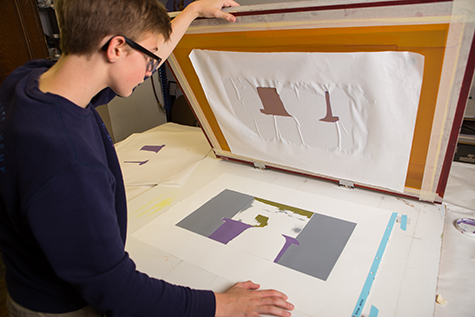The Necessary Guide to Understanding Screen Printing and Its Versatile Utilizes
Screen printing has a rich background that goes back to old times, developing right into an advanced strategy used across numerous markets today. This overview checks out the intricacies of the screen printing procedure, outlining its applications in fashion, advertising and marketing, and home decoration - 10:9 Design Company. Recognizing these fundamentals can open up imaginative potential for both creative and commercial jobs. The complying with areas will reveal necessary tips and methods to boost one's screen printing endeavors
The History of Screen Printing
Although screen printing has origins that trace back centuries, its advancement reflects the creative and technical innovations of different societies. Coming from ancient China, the technique was initially made use of for decorating textiles and later spread to Japan, where it became essential to Ukiyo-e woodblock printing. The technique moved to Europe in the 18th century, where it got popularity among artisans and industrial printers. The development of image solution in the 20th century changed screen printing, enabling more elaborate designs and greater efficiency. Musicians like Andy Warhol better propelled its popularity, using the medium to develop legendary jobs that mixed commercialism and fine art. By the late 20th century, screen printing had actually developed itself as a flexible method, employed in style, advertising and marketing, and great art. Today, it continues to develop, integrating electronic modern technology and broadening its applications across various sectors.
The Screen Printing Process Explained
Screen printing transforms imaginative visions into substantial styles through a collection of accurate actions. Initially, a picture is created and afterwards moved onto a screen, generally made of great mesh material extended over a frame. A light-sensitive emulsion is applied to the screen, which is revealed to light, solidifying in locations not covered by the picture. After washing out the unhardened emulsion, a pattern is developed.
Next off, the screen is put over the substratum, whether it be material, paper, or another product. Ink is then pushed with the open locations of the stencil making use of a squeegee, depositing the design onto the substratum below. This procedure can be duplicated for several shades, requiring separate displays for every hue. The published item is healed using warm to assure the ink sticks correctly, resulting in a sturdy, dynamic layout ready for use.
Kinds of Screen Printing Techniques

Furthermore, specialized methods, such as discharge screen printing, remove color from the fabric to produce softer prints, while foil screen printing uses metal aluminum foil to accomplish a glossy surface (10:9 Design contact). Each method offers unique attributes, accommodating numerous creative requirements and manufacturing scales, eventually increasing the opportunities within the screen printing domain
Applications of Screen Printing in Different Industries

Furthermore, the signage and advertising and marketing industries make use of screen printing for developing captivating displays and banners. This technique enables vibrant shades and intricate designs that catch try here focus. In Source electronics, screen printing is employed for applying conductive inks to motherboard, crucial for component connections. The home design market welcomes screen printing to create distinctive styles on fabrics and wall surface art. In general, screen printing acts as an essential tool across varied fields, improving items with customized and aesthetically appealing graphics.
Tips for Successful Screen Printing Projects
While embarking on a screen printing job, mindful attention to information can significantly enhance the last outcome. First, picking top notch products is essential; this includes the screen, inks, and substratums. Making use of suitable mesh counts can affect ink deposition and detail resolution. Preparation is equally essential; detailed cleaning of displays and proper exposure times ensure crisp prints.
Next, precise enrollment is vital for multi-color prints. Making use of placement devices can aid achieve accurate layering. Additionally, screening prints on scrap materials prior to manufacturing helps recognize potential concerns without wasting resources.

Frequently Asked Questions
What Materials Are Finest for Screen Printing on Material?
Cotton and polyester blends are perfect for screen printing on material because of their resilience and ink absorption. In addition, specialized textiles like silk or canvas can create one-of-a-kind appearances and coatings, boosting the overall check out here layout quality.
Exactly how Do I Clean and Maintain Screen Printing Devices?
To preserve and clean screen printing equipment, one must consistently wash screens with proper solvents, check squeegees for wear, lubricate relocating parts, and store all products in a completely dry, dust-free atmosphere to extend their life-span.
What Are the Environmental Impacts of Screen Printing?
Screen printing can have significant ecological influences, including chemical waste from inks and solvents, water usage throughout cleaning procedures, and energy consumption. Lasting practices and environmentally friendly products are essential for decreasing these negative effects.
Can Screen Printing Be Done in the house Effectively?
Screen printing can be effectively done at home with the appropriate materials and techniques. Enthusiasts can create high quality prints, though success depends on their ability level, equipment, and understanding of the process included.
What Are the Expenses Connected With Beginning a Display Printing Business?

Starting a screen printing company includes costs for tools, materials, and office. First expenditures generally vary from a few hundred to several thousand bucks, depending on the scale, top quality of equipment, and desired manufacturing capacity.
Screen printing has an abundant history that dates back to old times, progressing right into an innovative technique made use of throughout numerous markets today. An additional strategy, rotary screen printing, employs round screens, assisting in continuous printing on fabric rolls, thus improving performance for large manufacturings. Additionally, specialized strategies, such as discharge screen printing, eliminate color from the textile to develop softer prints, while aluminum foil screen printing applies metallic aluminum foil to achieve a glossy surface. In the style field, screen printing is widely used to create vivid designs on apparel, allowing brand names to display their special designs. Cotton and polyester blends are optimal for screen printing on textile due to their toughness and ink absorption.